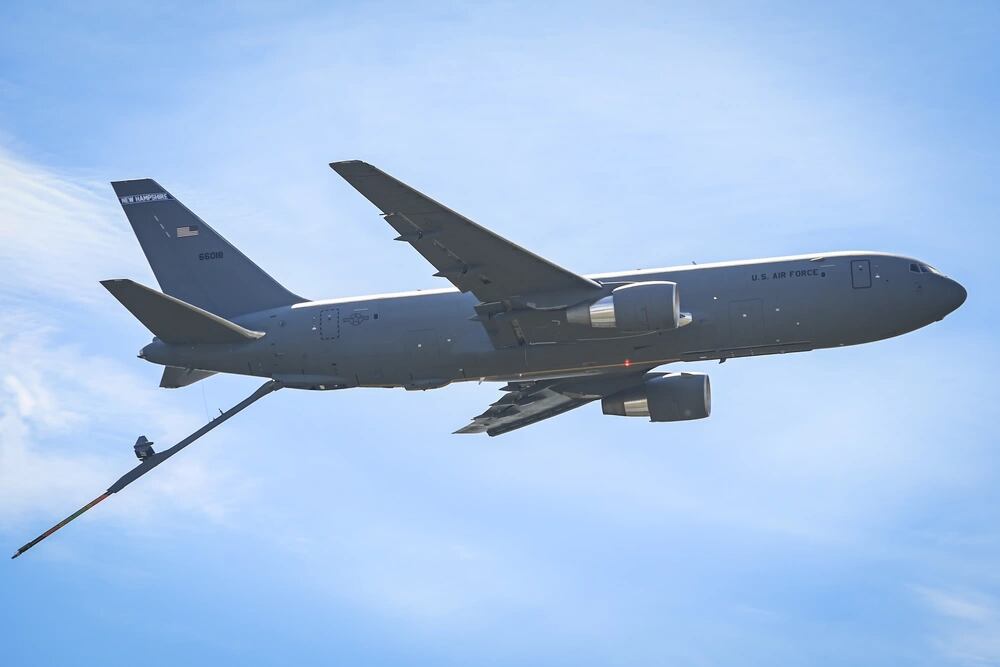Air Force officials are investigating a mishap that heavily damaged a KC-46 Pegasus tanker plane while it refueled a fighter jet last month, Air Force Times has learned.
The tanker was on its way from Glasgow Prestwick Airport in Scotland to Joint Base McGuire-Dix-Lakehurst, New Jersey, when it was tasked to gas up an F-15, an Air Force official confirmed Wednesday.
Investigators believe that during the rendezvous, the two aircraft were traveling at such different speeds that the refueling boom forcibly broke away from the fighter jet and slammed back into the KC-46, the official said. The Pegasus safely continued on to New Jersey after the mishap.
A photo posted Oct. 28 on an Instagram account for tanker memes appears to show a cracked refueling boom below a dented tail cone. The post voiced concerns about the jet’s safety, particularly as mobility officials experiment with using two-person crews instead of three in emergencies.
While the service believes it will cost at least $2.5 million to repair the KC-46, the official said he isn’t aware of any damage to the F-15.
“The incident is currently being investigated as a potential Class A mishap, with anticipated conclusion in late November,” Air Mobility Command spokesperson Capt. Natasha Mosquera said. “Final cost estimates will be determined at that time.”
“Brute force disconnects” are uncommon, but do happen, the official said. They recalled at least one or two other such in-flight tanker mishaps within the past few years.
The service said it does not suspect any systemic problems with the boom. It’s unclear if the Oct. 15 incident is related to multiple boom design issues that the Air Force added to the KC-46′s extensive list of faults in 2018, including that the pipe was too stiff to properly refuel lighter aircraft.
That has prevented the KC-46 from refueling the A-10C Thunderbolt II attack plane. Boeing is still redesigning the boom under a 2019 contract worth up to $55.5 million.
The Pegasus is intended to be a more versatile, resilient tanker than earlier designs and carry up to 65,000 pounds of cargo.
“AMC is confident in the KC-46′s ability to project and connect the joint force worldwide and will continue to meet global taskings in support of combatant command requirements,” Mosquera said.
The accident came about two months after the boom-retracting cable snapped on a New Hampshire Air National Guard KC-46, forcing the plane to land with the contraption extended. That event fell short of the threshold needed to classify it as the most severe kind of mishap.
RELATED

In September, the Air Force cleared the Pegasus to fly combat refueling missions around the world on airframes other than the A-10.
Air Mobility Command boss Gen. Mike Minihan argues the plane performs well enough to alleviate some of the military’s massive demand for tankers. Meanwhile, the Air Force and Boeing continue to chip away at multiple high-priority hardware and software problems.
Boeing must cover the cost of nearly $7 billion in needed fixes that have accumulated so far, about $2 billion more than the Air Force paid for the planes.
The service plans to buy at least 179 KC-46 airframes for $4.9 billion. Officials expect airmen will need to use workarounds while flying the jets until around 2025 or so, when significant design fixes are available.
Rachel Cohen is the editor of Air Force Times. She joined the publication as its senior reporter in March 2021. Her work has appeared in the Washington Post, the Frederick News-Post (Md.), Air and Space Forces Magazine, Inside Defense, Inside Health Policy and elsewhere.





